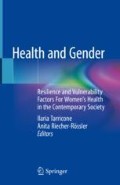Abstract
Gender has a significant health impact, and it should be always considered in the development of strategies for the prevention and treatment of health conditions related to reproductive and urogenital disorders. Biological differences can make women more prone to certain medical conditions. Furthermore, women’s health can be severely influenced by social vulnerability in societies where women continue to face discrimination or are victims of violence and social or cultural gender prejudice as these conditions can limit women’s access to health resources, information, and services [1].
Access this chapter
Tax calculation will be finalised at checkout
Purchases are for personal use only
References
World Health Organization. Gender, women and primary health care renewal: a discussion paper. Geneva: WHO; 2010.
Ribeiro PS, Jacobsen KH, Mathers CD, Garcia-Moreno C. Priorities for women’s health from the Global Burden of Disease study. Int J Gynaecol Obstet. 2008;102:82–90. https://doi.org/10.1016/j.ijgo.2008.01.025.
Chersich MF, Rees HV. Vulnerability of women in southern Africa to infection with HIV: biological determinants and priority health sector interventions. AIDS (London, England). 2008;22(Suppl 4):S27–40. https://doi.org/10.1097/01.aids.0000341775.94123.75.
Weinstock H, Berman S, Cates W Jr. Sexually transmitted diseases among American youth: incidence and prevalence estimates, 2000. Perspect Sex Reprod Health. 2004;36:6–10. https://doi.org/10.1363/3600604.
Glasier A, et al. Sexual and reproductive health: a matter of life and death. Lancet. 2006;368:1595–607. https://doi.org/10.1016/S0140-6736(06)69478-6.
Davies B, Turner KM, Frølund M, Ward H, May MT, Rasmussen S, Benfield T, Westh H, Danish Chlamydia Study Group. Risk of reproductive complications following chlamydia testing: a population-based retrospective cohort study in Denmark. Lancet Infect Dis. 2016;16(9):1057.
Committee on Practice Bulletins—Gynecology. Practice Bulletin No. 168: Cervical cancer screening and prevention. Obstet Gynecol. 2016;128(4):e111–30. https://doi.org/10.1097/AOG.0000000000001708.
Jemal A, Bray F, Center MM, Ferlay J, Ward E, Forman D. Global cancer statistics. CA Cancer J Clin. 2011;61(2):69–90. https://doi.org/10.3322/caac.20107. Epub 2011 Feb 4. Erratum in: CA Cancer J Clin. 2011;61(2):134.
Zegers-Hochschild F, Adamson GD, Dyer S, Racowsky C, de Mouzon J, Sokol R, Rienzi L, Sunde A, Schmidt L, Cooke ID, Simpson JL, van der Poel S. The international glossary on infertility and fertility care, 2017. Hum Reprod 2017;32(9):1786–1801. doi: https://doi.org/10.1093/humrep/dex234.
Ombelet W, Cooke I, Dyer S, Serour G, Devroey P. Infertility and the provision of infertility medical services in developing countries. Hum Reprod Update. 2008;14(6):605–21. https://doi.org/10.1093/humupd/dmn042. Epub 2008 Sep 26. Review.
Mascarenhas MN, Flaxman SR, Boerma T, Vanderpoel S, Stevens GA. National, regional, and global trends in infertility prevalence since 1990: a systematic analysis of 277 health surveys. PLoS Med. 2012;9(12):e1001356. https://doi.org/10.1371/journal.pmed.1001356. Epub 2012 Dec 18.
Inhorn MC. Global infertility and the globalization of new reproductive technologies: illustrations from Egypt. Soc Sci Med. 2003;56(9):1837–51.
Wischmann T, Thorn P. (Male) infertility: what does it mean to men? New evidence from quantitative and qualitative studies. Reprod Biomed Online. 2013;27(3):236–43. https://doi.org/10.1016/j.rbmo.2013.06.002. Epub 2013 Jun 19.
Kamischke A, Nieschlag E. Update on medical treatment of ejaculatory disorders. Int J Androl. 2002;25(6):333–44. Review.
WHO. Women and health: today’s evidence tomorrow’s agenda. Geneva: WHO; 2009.
Zhang L, Shah IH, Liu Y, Vogelsong KM, Zhang L. The acceptability of an injectable, once-a-month male contraceptive in China. Contraception. 2006;73(5):548–53. Epub 2006 Jan 20.
Meriggiola MC, Cerpolini S, Bremner WJ, Mbizvo MT, Vogelsong KM, Martorana G, Pelusi G. Acceptability of an injectable male contraceptive regimen of norethisterone enanthate and testosterone undecanoate for men. Hum Reprod. 2006;21(8):2033–40. Epub 2006 May 26.
Wang C, Swerdloff RS. Hormonal approaches to male contraception. Curr Opin Urol. 2010;20(6):520–4. https://doi.org/10.1097/MOU.0b013e32833f1b4a. Review.
McCulloch DK, Campbell IW, Wu FC, Prescott RJ, Clarke BF. The prevalence of diabetic impotence. Diabetologia. 1980;18(4):279–83.
Sullivan ME, Keoghane SR, Miller MA. Vascular risk factors and erectile dysfunction. BJU Int. 2001;87(9):838–45. Review.
Chiurlia E, D’Amico R, Ratti C, Granata AR, Romagnoli R, Modena MG. Subclinical coronary artery atherosclerosis in patients with erectile dysfunction. J Am Coll Cardiol. 2005;46(8):1503–6. Epub 2005 Sep 28.
Shifren JL, Monz BU, Russo PA, Segreti A, Johannes CB. Sexual problems and distress in United States women: prevalence and correlates. Obstet Gynecol. 2008;112(5):970–8. https://doi.org/10.1097/AOG.0b013e3181898cdb.
ACOG Practice Bulletin No. 141: management of menopausal symptoms. Obstet Gynecol. 2014;123(1):202–16. https://doi.org/10.1097/01.AOG.0000441353.20693.78. Erratum in: Obstet Gynecol. 2016;127(1):166.
Harris SS, Link CL, Tennstedt SL, Kusek JW, McKinlay JB. Care seeking and treatment for urinary incontinence in a diverse population. J Urol. 2007;177(2):680–4.
Minassian VA, Yan X, Lichtenfeld MJ, Sun H, Stewart WF. The iceberg of health care utilization in women with urinary incontinence. Int Urogynecol J. 2012;23(8):1087–93. https://doi.org/10.1007/s00192-012-1743-x. Epub 2012 Apr 12.
Barber MD, Maher C. Epidemiology and outcome assessment of pelvic organ prolapse. Int Urogynecol J. 2013;24(11):1783–90. https://doi.org/10.1007/s00192-013-2169-9. Review.
Trussell J. Contraceptive failure in the United States. Contraception. 2011;83:397–404.
Suggested Reading
DeLancey JO. What’s new in the functional anatomy of pelvic organ prolapse? Curr Opin Obstet Gynecol. 2016;28(5):420–9.
Gava G, Lantadilla C, Martelli V, Fattorini A, Seracchioli R, Meriggiola MC. Hot issues in female and male hormonal contraception. Minerva Ginecol. 2016;68(1):78–89.
Harper DM, DeMars LR. HPV vaccines - a review of the first decade. Gynecol Oncol. 2017;146(1):196–204.
Lukacz ES, Santiago-Lastra Y, Albo ME, Brubaker L. Urinary incontinence in women: a review. JAMA. 2017;318(16):1592–604.
Monteleone P, Mascagni G, Giannini A, Genazzani AR, Simoncini T. Symptoms of menopause - global prevalence, physiology and implications. Nat Rev Endocrinol. 2018;14(4):199–215.
Unemo M, Bradshaw CS, Hocking JS, de Vries HJC, Francis SC, Mabey D, Marrazzo JM, Sonder GJB, Schwebke JR, Hoornenborg E, Peeling RW, Philip SS, Low N, Fairley CK. Sexually transmitted infections: challenges ahead. Lancet Infect Dis. 2017;17(8):e235–79.
Weinberger JM, Houman J, Caron AT, Anger J. Female sexual dysfunction: a systematic review of outcomes across various treatment modalities. Sex Med Rev. 2018. https://doi.org/10.1016/j.sxmr.2017.12.004
Author information
Authors and Affiliations
Corresponding author
Editor information
Editors and Affiliations
Rights and permissions
Copyright information
© 2019 Springer Nature Switzerland AG
About this chapter
Cite this chapter
Gava, G., Seracchioli, R., Meriggiola, M.C. (2019). Urogenital and Reproductive Disorders. In: Tarricone, I., Riecher-Rössler, A. (eds) Health and Gender. Springer, Cham. https://doi.org/10.1007/978-3-030-15038-9_21
Download citation
DOI: https://doi.org/10.1007/978-3-030-15038-9_21
Published:
Publisher Name: Springer, Cham
Print ISBN: 978-3-030-15037-2
Online ISBN: 978-3-030-15038-9
eBook Packages: MedicineMedicine (R0)

